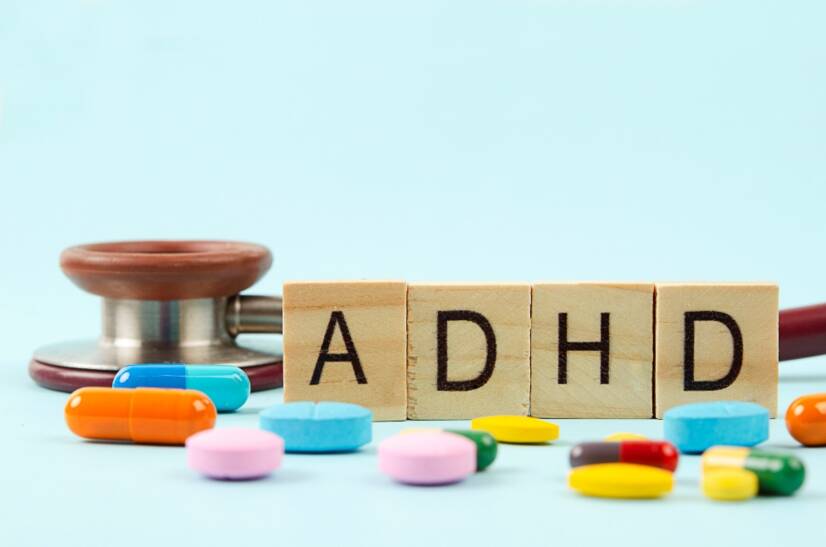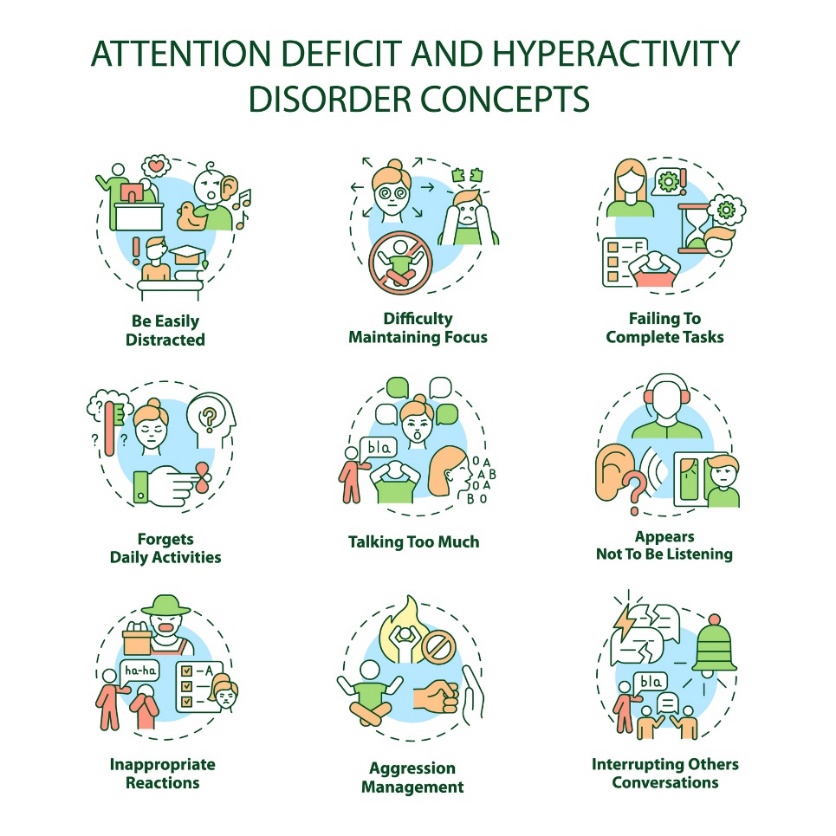- solen.sk - New treatment options for ADHD in Slovakia. Solen. MUDr. Jan Šuba
- genetickesyndromy.sk - ADHD: Attention deficit hyperkinetic disorder. Genetic syndromes online
- healthline.com - Everything You Need to Know About ADHD. Healthline. Traci Angel
- RABOCH, Jiří, Pavel PAVLOVSKÝ and Dana JANOTOVÁ. Psychiatry: the minimum for practice. 5th edition. Prague: Triton, 2012. ISBN 978-80-7387-582-4
ADHD: Attention deficit hyperactivity disorder. Causes, symptoms

ADHD characterises a behavioural disorder in which the ability to concentrate and pay attention is impaired and hyperactive behaviour is present. Why does the disorder occur and how does it manifest itself? Is it possible to treat ADHD?
Most common symptoms
- Speech disorders
- Depression - depressed mood
- Concentration disorders
- Memory disorders
- Mood disorders
- Fatigue
- Anxiety
Characteristics
You can read the etiology and factors of the onset, manifestations, treatment of ADHD and many other interesting information in the article.
ADHD is a hyperkinetic psychiatric disorder. Its prevalence in school-age children is estimated at 10-12%. ADHD is most commonly diagnosed between the ages of 6 and 9 years as part of a child's entry into the school environment.
Males are more often affected.
ADHD is characterized by impaired and reduced ability to concentrate and pay attention, impaired control of emotional impulses, presence of inner restlessness and hyperactivity of the individual.
ADHD is characterized by an early onset. The manifestations appear in the child as early as the first seven years of life.
There is a combination of overactive behaviour with marked inattention and inability to maintain sustained concentration and attention on a single activity.
A characteristic feature is also the absence of motivation with a tendency for the individual to change activities without completing the first activity/task. ADHD is also characterised by poor organisation of work and disorganisation in daily life.
However, the course and symptoms depend on the exact type and form of ADHD that the individual has.
According to the literature, the manifestations of ADHD should be evident before the age of 7 and the condition described must last for at least 6 months. However, the condition must not be caused by another possible psychological disorder of the child, such as anxiety disorder, depression, mood disorder or schizophrenia, among others.
This hyperkinetic disorder has a chronic course. It can persist from childhood into adulthood and usually has a negative impact on the individual's social adaptation. According to the literature, ADHD progresses to adulthood in more than 50 % of cases.
Causes
The etiology of ADHD is multifactorial complex. It includes genetic, biological, psychosocial and external factors.
The primary risk factor for ADHD is genetic predisposition.
Genetic factors have been confirmed by studies indicating a higher prevalence of ADHD in first-degree family relatives than in the general population at a ratio of 24% to 6%. A higher prevalence is also seen in second-degree family relatives.
Some studies confirm that ADHD is present in 18% of biological parents of children with ADHD.
A higher prevalence has also been observed in the presence of psychiatric disorders such as depression, anxiety disorders or alcohol or psychoactive substance dependence.
An association between the development of ADHD and antenatal and delivery health complications, low birth weight of the child, and maternal use of alcohol, nicotine and other psychoactive substances has been reported.
A possible contributing factor to the manifestation of ADHD is improperly chosen upbringing, institutional upbringing, disturbed quality of relationships in the family or school environment of the individual.
In spite of medical advances, the biological determinant of ADHD is still unknown. However, abnormalities in the prefrontal region of the brain are present. Dysregulation of inhibitory activity in the frontal region of the individual's brain is evident.
Disruption of the involvement of certain neurotransmitter systems in the body is also suspected.
Symptoms
Hyperactivity and frequent impulsivity are evident in the child. Frequent injuries resulting from the child's inattention and excessive activity are also a consequence.
Impaired school performance resulting from a reduced ability to concentrate and conform to certain norms is also a characteristic feature. Children and adolescents with ADHD often have problems in socialising and adapting to new environments.
There may also be problems in relationships with parents, siblings or peers.
Later in life, if ADHD is left untreated, some form of aggression and delinquency is possible.
ADHD is often chronic in nature and affects approximately 50% of adults. These individuals are at increased risk of stress, relational disagreements, disorganisation or a decline in social and economic status.
Possible manifestations and symptoms of ADHD:
- Inability to concentrate
- Inability to concentrate for long periods of time
- Ease of distraction
- Forgetting to complete tasks
- Hyperactivity
- Impulsive behaviour
- Inappropriate responses to stimuli
- Impatience, distractibility
- Difficulty with quiet activity
- Interrupting conversations and jumping into speech
- Disorganisation of normal daily activities
However, children with ADHD are also very sensitive and have their own strong positive points. They are often very creative, full of imagination with their own rich inner world.
However, the symptoms depend on the exact type and form of ADHD that the individual has. There are three basic types of ADHD for the non-expert public:
- Predominantly inattentive
- Predominantly hyperactive
- Combined form of ADHD

Diagnostics
The diagnostic procedure involves a detailed assessment of the child's behaviour. The basis is a specific ADHD classification questionnaire divided into two main assessment parts - inattention and hyperactivity. The assessment scale can be found at the end of this article.
The person should exhibit most (at least 6) of the major specific symptoms for the particular type and form of ADHD.
Symptoms should also interfere with the individual's daily life when diagnosing ADHD.
The symptoms of ADHD may not be immediately apparent in a medical setting, and therefore the diagnosis is extensive. It involves repeated visits, especially when pathological symptoms worsen or reappear.
The examination should consist of a thorough taking of medical, personal, school/work and family histories, and an interview with the patient, parent or partner.
Before making a diagnosis, the examining physician must rule out other medical diagnoses such as depression, anxiety, schizophrenia or certain sleep problems.
An MRI of the brain may be performed to see the internal structures of the brain area in detail. EMG (electromyography), the measurement of the brain's electrical impulses for the possible presence of abnormalities, is also an option.
However, most individuals with ADHD will not be found to have any problems during a physical or physical examination. However, an examination is needed to evaluate other possible medical disorders as part of a differential diagnosis.
Myths about ADHD
Myth: Only children have ADHD
While the diagnostic process should show the presence of specific ADHD symptoms by age 7, many individuals remain undiagnosed into adulthood. The interest and cooperation of parents themselves has a great impact on early diagnosis.
It is unlikely that excessive hyperactive behaviour will be evident in an adult individual with ADHD, but rather an inner restlessness, an inability to sustain sustained attention and concentration on a particular activity.
Myth: Hyperactivity is always present in ADHD.
ADHD disorders include many other symptoms under ADHD, based on which the diagnosis is divided into several types.
The inattention-predominant form of ADHD does not exhibit excessive hyperactivity. Such an individual is often described as dreamy, inattentive, and often easily distracted by various stimuli. He or she may also be inattentive, careless, or forgetful in daily routines.
ADHD Rating Scale
Symptoms of distractibility and inattention table
| Symptoms of inattention and distractibility - at least 6 or more symptoms must persist for at least 6 months |
| 1 Unable to concentrate on details, makes mistakes due to inattention at school, work, or other routine activities. |
| 2. Often has difficulty maintaining attention during school/work duties or fun activities. |
| 3. Often seems as if he/she is not listening or perceiving even when spoken to directly. |
| 4. Often disregards instructions and is unable to complete schoolwork, homework or work responsibilities. |
| 5. Has difficulty organizing chores and other daily activities. |
| 6. Often avoids, dislikes, or is reluctant to engage in activities that require concentrated mental effort. |
| 7. Often loses things that are needed to perform duties or engage in certain activities (toys, schoolwork, pencils, books, glasses...) |
| 8. Is easily distracted and distracted by external stimuli/stimulus. |
| 9. Often forgets daily routines. |
Symptoms of hyperactivity and impulsivity in the table
| Symptoms of hyperactivity and impulsivity - at least 6 symptoms must persist for at least 6 months |
| 1. Often behaves restlessly, moves arms and legs uncontrollably, fidgets, is restless. |
| 2. Frequently leaves his/her seat in class, at the desk, or in other situations where he/she is expected to stay in one place. |
| 3. Frequently runs or climbs in situations where this is inappropriate (in adolescents or adults, this symptom may manifest as a subjective feeling of restlessness). |
| 4. Often has difficulty engaging in quiet play or inactive leisure activities. |
| 5. Feels as if he or she is always in a hurry or is acting energetically, as if driven by a motor. |
| 6. Talks frequently and excessively. |
| 7. Often blurts out an answer before the question itself is finished. |
| 8. Often has trouble waiting his or her turn. |
| 9. Often interrupts and jumps in other people's speech. |
How it is treated: ADHD
ADHD treatment options: medication and psychotherapy
Show moreADHD is treated by
Other names
Interesting resources










